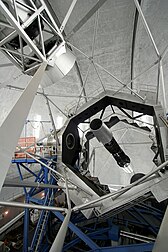Zerodur


Zerodur is a lithium-aluminosilicate glass-ceramic manufactured by Schott AG. Zerodur has a near zero coefficient of thermal expansion (CTE), and is used for high-precision applications in telescope optics, microlithography machines and inertial navigation systems.[2][3][4]
Applications[edit]

The main applications for Zerodur include telescope optics in astronomy[5] and space applications,[6] lithography machines for microchips and displays,[7] and inertial measurements systems for navigation.[8][9]
In astronomy, it is used for mirror substrates in large telescopes such as the Hobby-Eberly Telescope,[10] the Keck I and Keck II telescopes,[11] the Gran Telescopio Canarias,[12] the Devasthal Optical Telescope,[13] the European Southern Observatory's 8.2 m Very Large Telescope,[14] and the 39 m Extremely Large Telescope.[15]
In space, it has been used for the primary mirror of SOFIA’s telescope,[16] for the imager in Meteosat Earth observation satellites,[17] and for the optical bench in the LISA Pathfinder mission.[18]
In microlithography, Zerodur is used in wafer steppers and scanner machines for precise and reproducible wafer positioning.[19][20] It is also used as a mirror substrate material in refractive optics for EUV lithography.[21]
In inertial measurement units, Zerodur is used in ring laser gyroscopes.[22]
Properties[edit]
Zerodur has both an amorphous (vitreous) component and a crystalline component. Its most important properties[23] are:
- The material exhibits a particularly low thermal expansion, with a mean value of 0 ± 0.007×10−6 K−1 within the temperature range of 0 to 50 °C.[24][25]
- High 3D homogeneity[25] with few inclusions, bubbles and internal stria.
- Hardness similar to that of borosilicate glass.
- High affinity for coatings.
- Low helium permeability.
- Non-porous.
- Good chemical stability.
- Fracture toughness approximately 0.9 MPa·m1/2.[26][27]
Physical properties[edit]
- Dispersion: (nF − nC) = 0.00967
- Density: 2.53 g/cm3 at 25 °C
- Young's modulus: 9.1×1010 Pa
- Poisson ratio: 0.24
- Specific heat capacity at 25 °C: 0.196 cal/(g·K) = 0.82 J/(g·K)
- Coefficient of thermal expansion (20 °C to 300 °C) : 0.05 ± 0.10×10−6/K
- Thermal conductivity: at 20 °C: 1.46 W/(m·K)
- Maximum application temperature: 600 °C
- Impact resistance behavior is substantially similar to other glass[28]
See also[edit]
References[edit]
- ^ "Secondary Mirror of ELT Successfully Cast - Largest convex mirror blank ever created". www.eso.org. Retrieved 22 May 2017.
- ^ "Zerodur®". Archived from the original on July 24, 2011. Retrieved September 4, 2011.
- ^ Viens, Michael J (April 1990). "Fracture Toughness and Crack Growth of Zerodur" (PDF). NASA Technical Memorandum 4185. NASA. Retrieved 28 August 2011.
- ^ "Schott AG Zerodur description". Archived from the original on February 1, 2014.
- ^ Döhring, Thorsten (May 2019). "Four decades of ZERODUR mirror substrates for astronomy". Proceedings, 4th International Symposium on Advanced Optical Manufacturing and Testing Technologies: Large Mirrors and Telescopes. 7281. doi:10.1117/12.831423. Retrieved 10 May 2024.
- ^ Carré, Antoine (May 2023). "Comprehensive review of the effects of ionizing radiations on the ZERODUR® glass ceramic". Journal of Astronomical Telescopes, Instruments, and Systems. 9 (2). doi:10.1117/1.JATIS.9.2.024005. Retrieved 10 May 2024.
- ^ "SCHOTT Strengthens Glass Substrate Portfolio". Printed Electronics Now. September 29, 2023.
- ^ Sokach, Stephen. "ZERODUR: The Highly Technical Glass-Ceramic". Tech Briefs. Retrieved 10 May 2024.
- ^ "Zerodur". Mindrum Precision. Retrieved 10 May 2024.
- ^ "Hobby-Eberly Telescope | McDonald Observatory". mcdonaldobservatory.org. Retrieved 2024-07-12.
- ^ "A Mirror's Perfect Reflection". W.M. Keck Observatory. Retrieved 10 May 2024.
- ^ "Description of the GTC". Gran Telescopio CANARIAS. Retrieved 10 May 2024.
- ^ "3.6 m DOT Telescope". ARIES. Retrieved July 7, 2024.
- ^ "Very Large Telescope". ESO. Retrieved 10 May 2024.
- ^ "Mirrors and Optical Design". ESO. Retrieved 10 May 2024.
- ^ Krabbe, Alfred (June 2000). "SOFIA telescope". Proceedings, Airborne Telescope Systems. 4014. arXiv:astro-ph/0004253. doi:10.1117/12.389103. Retrieved 10 May 2024.
- ^ "MTG (Meteosat Third Generation) - eoPortal". www.eoportal.org. Retrieved 2024-07-12.
- ^ "LISA Technology Package Optical Bench Interferometer During Calibration". ESA. Retrieved 10 May 2024.
- ^ Hartmann, Peter. "SCHOTT – Ultra low expansion glass ceramic ZERODUR" (PDF). Max-Planck-Institut für Astronomie. p. 49. Retrieved 10 May 2024.
- ^ Jedamzik, Ralf (2014). "Glass ceramic ZERODUR enabling nanometer precision". Proceedings, Optical Microlithography XXVII. 9052. doi:10.1117/12.2046352. Retrieved 10 May 2024.
- ^ Mitra, Ina (September 2022). "ZERODUR: a glass-ceramic material enabling optical technologies". Optical Materials Express. 12 (9): 3563. doi:10.1364/OME.460265. Retrieved 10 May 2024.
- ^ Pinckney, Linda R. (2003). "Glass-Ceramics". Encyclopedia of Physical Science and Technology (Third Edition): 807–816. doi:10.1016/B0-12-227410-5/00293-3. Retrieved 10 May 2024.
- ^ "ZERODUR® Extremely Low Expansion Glass Ceramic: SCHOTT Advanced Optics - SCHOTT AG". www.schott.com. Retrieved 15 April 2018.
- ^ "SCHOTT CTE Grades". Archived from the original on October 4, 2013.
- ^ a b [1][dead link]
- ^ Viens, Michael J (April 1990). "Fracture Toughness and Crack Growth of Zerodur" (PDF). NASA Technical Memorandum 4185. NASA. Retrieved 28 August 2011.
- ^ Hartmann, P. (18 December 2012). "ZERODUR - Deterministic Approach for Strength Design" (PDF). Optical Engineering. 51 (12). NASA: 124002. Bibcode:2012OptEn..51l4002H. doi:10.1117/1.OE.51.12.124002. S2CID 120843972. Retrieved 11 September 2013.
- ^ Senf, H; E Strassburger; H Rothenhausler (1997). "A study of Damage during Impact in Zerodur" (PDF). J Phys IV France. 7 (Colloque C3, Suppltment au Journal de Physique I11 d'aotit 1997): C3-1015-C3-1020. doi:10.1051/jp4:19973171. Retrieved 31 August 2011.